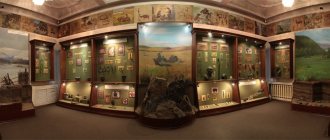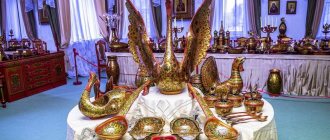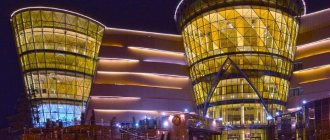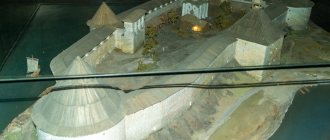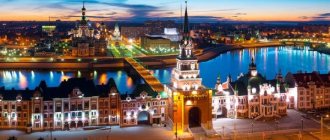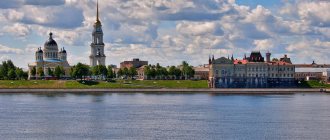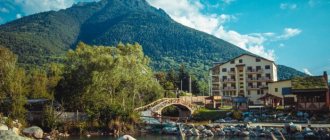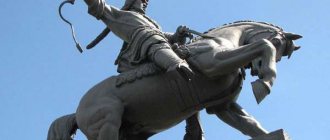Kursk: brief information
From the capital of Russia to this charming town is about 500 km. The settlement has a rich history and many different monuments. Kursk is located in a picturesque place on the Seim River. Today its population exceeds 400 thousand people. There are no problems with tourist infrastructure. There are also various entertainment centers, as well as shops and boutiques for every taste. The vast majority of tourists coming to the city of Kursk are more interested in sights, because you can have a delicious meal or go to the cinema in your native locality. There should be no problems with the cultural program. The city has many museums to suit every taste; there are unique architectural monuments, as well as modern sculptural compositions. Don’t forget to take a camera and a spare battery with you on your trip; there are plenty of places to take pictures here. You can go to Kursk at any time of the year, the climate is mild, and the city landscapes look equally good under the snow cover and in the riot of vegetation.
A little history
The first mentions of this city in historical documents date back to 1032. Already at that time it was quite large and famous, as it was located on a significant trade route. According to one version, the settlement was founded by the peoples of Scandinavia. Eminent historians still argue about the origin of the city’s name. There are two versions. If you believe the first, then the settlement was named after the river (“Kur”) on which it stands. Opponents of this theory say that the city was named after the partridges that live in its surroundings. These birds are also depicted on the modern coat of arms of the city. In 1095 the Kursk Appanage Principality was founded. In the sixteenth century, a reliable fortress was erected here, and for two centuries the city was a significant military-strategic object for the entire Kievan Rus. But already in the eighteenth century, Tatar-Mongol troops heavily plundered and destroyed this settlement. However, it was restored and played a significant role in the Great Patriotic War. Many monuments in Kursk are dedicated specifically to the Battle of Kursk, which significantly influenced the course of the war. Nowadays, the settlement proudly bears the title of hero city. This settlement is also included in the list of the cleanest and most well-groomed cities in Russia.
Museum-diorama “Arc of Fire. Kursk direction"
Belgorod State Historical and Art Museum…
Belgorod
The diorama museum was opened in Belgorod in 1987. The picturesque canvas of the diorama with an area of 1005 square meters became one of the largest works of art dedicated to the Great Patriotic War. The painting was created by battle painters from the Mitrofan Grekov Studio. The creative team was led by Nikolai But.
Veterans of the Battle of Kursk and their relatives donated front-line relics to the museum - documents, awards, army newspapers and personal belongings of soldiers. Today they form the basis of the collection. Paintings and graphic works dedicated to the Battle of Kursk are also stored here. Military equipment is displayed on the street.
The museum regularly hosts thematic interactive quizzes for children and teenagers, and researchers give lectures on the military history of the region. In the Liberation Hall of Belgorod there is an electronic Book of Memory: museum staff help visitors find information about the award, military path or burial place of participants in the Great Patriotic War.
We remember the war...
One of the symbols of Kursk is the Kursk Bulge memorial. The open-air museum stretches for almost a kilometer along Victory Boulevard. It is impossible not to notice the complex. It includes the Triumphal Arch, the monument to Zhukov, and the Church of St. George the Victorious. Here you can also see a sculpture dedicated to the victims of the shootings, the figure of an unknown soldier and the sign of the city of military glory. There is also its own alley of military equipment. The sights of Kursk related to the Second World War do not end there. The local Officers' House houses a museum of the Battle of Kursk. Here you can learn more about how the battle took place, see awards and personal belongings of the fighters.
Museum-Reserve "Prokhorovskoye Field"
State Military Historical Museum-Reserve…
Prokhorovsky district
The Prokhorovskoye Field Museum-Reserve was opened in May 1995. Military graves, monuments, sculptures, and military equipment on its territory tell the history of the tank battle better than any words. At the site where the fiercest battles took place on July 12, a 59-meter-high belfry was installed. In memory of the three battlefields of Russia - Kulikovo, Borodino and Prokhorovsky - its bell rings three times an hour.
Not far from the belfry there is a museum “The Third Military Field of Russia”. His collection includes soldiers' letters, documents, photographs and personal belongings of soldiers. On the interactive map you can see how the battle went. Also on the territory there are trenches, dugouts and shelters for equipment, some of which you can go down into.
The museum-reserve houses Russia's first tankodrome - an open area for displaying military vehicles. Similar testing grounds exist only in England and the Czech Republic. The tankodrome fleet has 12 pieces of equipment, including an armored personnel carrier, infantry and airborne combat vehicles, and an armored vehicle.
Let's find out the story
Kursk museums will delight tourists with exhibitions for every taste. There is also a planetarium in the city, and you can also see the trams. But it still makes sense to start your acquaintance with the city with the Museum of Local Lore and the Military History Museum. In the first one you can see original pieces of furniture and household items, original documents and works of art. To make it easier to view the collections, they are divided into three categories. These are our days and the USSR, the ancient history of the region, as well as an overview of natural resources. The scale is impressive - the total area of exhibits is 1200 hectares, the number of valuable items in the collection is more than 170 thousand. This is an incredible amount for a local history museum.
Unique archaeological museum
The Kursk Archaeological Museum is an unusual entity for Russia. The thing is that there is not only an exposition for visitors to see here. The collection is regularly updated. The thing is that the museum specializes exclusively in conducting excavations in a specific region and studying the valuable objects found. At the same time, the museum’s activities are aimed primarily at finding and preserving architectural monuments. A variety of objects are explored - ancient settlements and sites, mounds and burials of various periods. The museum is located in the house of the merchant Khloponin, which is otherwise called the Romodanovsky Chambers. This building is an architectural monument and looks great even today thanks to regular restoration work.
Cultural life
The city of Kursk is known not only as a place of great battles, but also as a modern cultural center. A must-visit object is the art gallery named after. A. Deineki. Today you can see about 8.5 thousand exhibits here. The collection presents outstanding examples of European sculpture, painting and graphics. You can see folk art items here. In Kursk you can get to know the theater arts better. The Pushkin Drama Theater is open for adults. For children and teenagers - theater for young spectators or puppets. The city has four large parks. On holidays, folk festivals and various entertainment programs are held here.
Museums and galleries
The most complete and structured information about the city can be obtained by visiting museums. There are a considerable number of them in the Course - with different themes, size of exhibitions, designed for a wide variety of categories of visitors.
- Military History Museum of the Battle of Kursk. Since this city has earned the title of “City of Military Glory,” the main attractions of Kursk and the Kursk region are dedicated to its military past. One of the main museums of the city is located on the second floor of the House of Officers. Since 1963, visitors have the opportunity to familiarize themselves with more than 10 thousand elements of the exhibition, which relate to the period of preparation and conduct of the Battle of Kursk. Here you can see samples of German and Soviet weapons, chronicles and photographs. This institution is included in the museum system of the Ministry of Defense.
- Kursk Regional Art Gallery named after. A.A.Deineki. About 8 thousand paintings by Western European and domestic artists are collected under its roof. Alexander Alexandrovich Deineka himself is a native of Kursk, a famous painter, whose collection of works occupies an impressive place in the gallery. The artist’s name is also famous outside the city. First of all, according to his sketches, mosaics were created that decorate the Moscow metro stations (“Mayakovskaya” and “Novokuznetskaya”), the building of Moscow State University and the Kremlin Palace.
- Kursk State Regional Museum of Local Lore is the oldest in the city. Its existence began in 1903. The collection of more than 170 thousand items was replenished thanks to purchases in antique stores, charitable contributions and proceeds from nationalized real estate.
- Kursk Literary Museum. The sights of Kursk can introduce you not only to outstanding military exploits, but also to the extensive cultural history of the region. After all, the names of many outstanding creative personalities are associated with these lands: Afanasy Fet, Sylvester Medvedev, Karion Istomin, Arkady Gaidar and many others. The museum was opened relatively recently - in 2009. But at the same time it boasts an area of 563 square meters, which houses 8 exhibitions. They talk about the life and work of famous fellow countrymen from the 11th century to the present day.
- The Museum “Young Defenders of the Motherland” is absolutely unique. He is the only one in all of Russia who tells visitors about the children of war, of whom there were about 300 thousand people. Of these, 60 thousand did not survive the terrible years and laid down their lives for their Motherland. The museum’s extensive collection tells about all of them, including personal belongings of children, their Komsomol cards, letters, military awards, remains of weapons and uniforms.
- Museum "Kursk Nightingale". Its doors opened on June 4, 2007 - on the day that, according to the folk calendar, is considered the nightingale. There are more than a thousand exhibits on this topic. The songbird, which is considered a symbol of the region, tells visitors about the sights of the city of Kursk, its musical and visual history.
- Fire and Rescue Museum. This unusual museum tells the history of the emergence and development of fire fighting in Kursk. Despite the fact that no more than 7 thousand people visit it per year, 17 foreign delegations have already visited it. The highlight among the exhibits is a real fireman's hand pump, which dates back to the beginning of the 20th century.
- Museum of Urban Electric Transport. It was opened in 1988. The most interesting part of the exhibition is rightfully considered to be the one dedicated to the pre-revolutionary history of the tram. Many original documents have been preserved here, and there is also an exclusive painting painted to order. Electric transport in Kursk began to function even earlier than in Moscow and St. Petersburg. Visitors will be happy to be told how this happened during the excursion.
- Kursk State Museum of Archeology. The history of archaeological excavations in the region is also full of amazing facts and finds. The exhibition includes bronze brooches, silver frontal rims, a belt plate in the form of a heraldic shield, and many other absolutely unique exhibits. The museum building itself can be considered one of the architectural landmarks of Kursk. This 18th-century estate complex was built in the style of Moscow Rus' of the 16th-17th centuries. At the moment it is the only surviving secular building.
Other museums in Kursk
There is also an exhibition in this city dedicated to the exploits of minor residents of these places during the Second World War. The museum is called “Young Defenders of the Motherland.” Here you can learn about the exploits of very young children in difficult times, as well as many interesting stories related to their everyday life. It is difficult to list all the attractions of Kursk; there are only 13 museums in this city. In addition to those described above, there are: literary, zoological, automobile and even its own cosmonautics museum. Kursk also has its own planetarium. In addition to the Deineka art gallery, the city has a gallery of modern art and an exhibition hall of the Art Fund. As in any other large city, temporary exhibitions and various fairs are held here periodically, where interesting items can not only be viewed, but also purchased.
Archive number No. 36 (1090) dated September 1, 2015 — News
NATIVE SPACE
The newspaper “Friend for a Friend” continues the project “Tourist Map of the Kursk Region”, the goal of which is to tell readers about the sights and interesting places of our region. Our route today will pass through places of military glory.
The Battle of Kursk, which lasted almost 50 fiery days and nights, went down in history as one of the most important events of the Great Patriotic War. It became a turning point during the fighting. After the defeat of the German troops near Kursk and Orel, the strategic initiative finally passed into the hands of the Soviet command. “Berlin is still far away, but in these lights the final victory was already visible,” wrote Marshal Georgy Zhukov, recalling the Battle of Kursk.
The northern face of the Fire Arc is the territory of the Ponyrovsky and Fatezhsky districts. The Teplovsky, Olkhovatsky and Molotychevsky heights became the scene of a deadly battle between the Red Army and the selected forces of the Wehrmacht in July 1943; the bloodiest clashes of the Battle of Kursk took place here. History comes to life in museums and memorials dedicated to those heroic and sometimes incredibly tragic events.
Ponyri: the front line of defense
Anti-tank hedgehogs, barbed wire fences, trenches and trenches - you can see a fragment of the defense line with your own eyes in the village of Ponyri. The historical and memorial museum of the Battle of Kursk, located in the regional center, was opened in 1964. Four years ago he moved to a new building.
The museum exposition tells about the first days of the war in the region, the occupation, the partisan movement and the liberation of the region on February 13, 1943. A large number of materials are devoted to preparations for the battle on the Kursk Bulge and the Ponyrovsk defensive operation of July 5–11, 1943. A special place in the exhibition is occupied by copies of nine banners of military units that took part in defensive battles.
The diorama “The Battle for Ponyri Station on July 10, 1943” reflects the real events and real heroes of that day. The commander of the rifle battalion of the 9th Guards Airborne Regiment of the 4th Guards Airborne Division, Captain Alexander Zhukov, skillfully led the battle for the Ponyri station, during which two tanks, more than 700 German soldiers and officers were destroyed, and two planes were shot down. Posthumously, he and his deputy for political affairs of the guard, Captain Nikolai Kozyakov, were awarded the titles of Heroes of the Soviet Union.
On the territory of the museum there is an open-air exhibition complex “Front Line of Defense. July 1943." It was there that a fragment of the defense line was recreated down to the smallest detail.
At one time, Marshal Konstantin Rokossovsky, poets Konstantin Simonov and Evgeny Dolmatovsky visited the Ponyrovsky museum.
How to get there:
Ponyri village, st. Lenina, 1. Ticket price: adults – 15 rubles, students – 10 rubles, children – free, foreigners – 50 rubles. You can book a tour of the museum or grounds, or take a ride on a road train. Phone (47135) 2-15-32.
Teplovsky Heights: “the key to Kursk”
On the eve of the 70th anniversary of Victory in the Great Patriotic War, the Teplovsky Heights monument was opened in the Ponyrovsky district. The three-level observation deck, shaped like an anti-tank mine, offers a panoramic view of the places where fierce battles took place during the Great Patriotic War.
The 17-meter monument was actually built on the highest point in our region. They say that in good weather you can even see Kursk from here with binoculars.
Teplovsky Heights received their name from the village of Teploye, located at the junction of Fatezhsky and Ponyrovsky districts. German generals called the Teplov Heights “the key to Kursk.” Here, in July 1943, one of the bloodiest battles of the Battle of Kursk unfolded. The Germans tried to capture height 253.5, from which they could cut off Soviet soldiers from communications and deprive them of any support from the rear. After the air raid, the Wehrmacht infantry regiment, supported by 40 tanks, moved to the heights. To begin with, the Nazis wanted to capture height 234.0, but the Red Army artillerymen, who were under incessant mortar fire from the Germans, managed to hold back the enemy’s advance and throw him back to their original positions. More than 40 thousand people died in the area of the Olkhovatsky-Teplovsky-Molotychevsky Heights ridge.
How to get there:
along the Moscow highway - towards Orel. In the area of the village of Verkhniy Lyubazh there is a turn onto the road “Verkhniy Lyubazh - Ponyri”, which passes through the village of Teploye. An independent visit to Teplovsky Heights will cost schoolchildren and students 20 rubles; adults 40 rubles; for foreigners 50 rubles. You can book a tour. Phone (47135) 2-15-32.
What to see along the way.
Not far from the village of Molotychi, Fatezhsky district, there is a memorial “Poklonnaya Height 269”.
The “Angel of Peace” monument is installed here - a 35-meter stele, the top of which is crowned by an 8-meter angel soaring in the sky and as if calling for peace on Earth. During the day, the figure of an angel shines in the rays of the sun, and in the evening it is visible far away thanks to the backlight.
Memorial in Freedom: excursion to Rokossovsky's dugout
In the town of Svoboda, Zolotukhinsky district, there is a historical and memorial museum “Command Post of the Central Front”. Among the numerous exhibits are the personal belongings of Marshal Konstantin Rokossovsky, commander of the Central Front.
On the territory of the memorial there is Rokossovsky’s dugout, or rather, its reconstruction. There is also a bust of the famous marshal, a sculpture of a liberating warrior and samples of military equipment - mortars, cannons, and a tank. More than 20 thousand people visit the museum every year. Among the guests of honor came here Prime Minister Dmitry Medvedev, Defense Minister Sergei Shoigu, and Patriarch of All Rus' Kirill.
How to get there:
The memorial is located in the town of Svoboda, Zolotukhinsky district, at the address: Sovetskaya Street, 32. Admission for children is free, students will have to pay 40 rubles, adults – 50, foreigners – 70 rubles. You can book a tour. Phone (47151) 4-13-56.
Big Oak: Burnt Memory of War
The Big Oak Museum near Zheleznogorsk is the only museum in Russia built on the site of a burned village. In the Soviet press she was called “the sister of Belarusian Khatyn.”
On the early cloudy morning of October 17, 1942, 44 residents of the village of Bolshoi Dub - women, old people and children (there were 26 children, five of them were less than a year old) - were shot and then burned by a Nazi punitive detachment.
The killers left no witnesses. Yet several residents miraculously managed to survive. The museum contains memories of eyewitnesses, which even today give chills to the skin. On that fateful morning, Nastya Voronina was returning from her godmother, who lived in a neighboring village. “When I approached the collective farm buildings, I saw a group of fascist punitive forces coming out of the forest. Hiding in the bushes, I began to observe,” Anastasia Andreevna later said. “Some of the punitive forces quickly entered the village, and the rest began to surround it. Those who broke into the village began to drive residents out of their homes. Screaming, swearing... And then machine gun shots, screams, and crying were heard. I cried, got scared and ran into the forest... Five days later they allowed me to bury my relatives. My mother, brother and two sisters died and were so burned that it was difficult to recognize them.”
The Germans didn’t want to get their hands dirty, so they brought in teenagers from neighboring villages to sort out the bodies. “Between the burnt hut and the barn lay those who had been shot. Many had their faces and clothes burned. They were doused with gasoline before being burned. Two female corpses lay to the side. They hugged their children to their chests, one of them covered the child with a hollow fur coat... Even after death, they could not be separated,” recalled Pavel Arbuzov.
Where the villagers' houses once stood, today there are seven black, smoky log cabins. Each one contains a symbolic chimney with a bell. They call every 150 seconds, according to the number of people buried. Along with the Big Oak, the Germans destroyed two more villages. In the village of Kholstinka, people were burned alive... Of the one and a half hundred civilians killed during the punitive operation "White Bear", 77 were children...
The museum's archives contain photographs of fascist atrocities, lists of victims and memories of eyewitnesses. A significant part of the exhibition is dedicated to the partisan movement.
How to get there:
The memorial is located 100 kilometers from Kursk. You can get there by car, by regular bus heading to Zheleznogorsk, or by minibus from the city of miners. The Big Oak Memorial stop is located almost in the middle between the Mikhailovka settlement and Zheleznogorsk - seven kilometers from both settlements. Entrance to the museum is free for children (with a guided tour – 20 rubles), for adults – 20 rubles (with a guided tour – 50). Phone (47148) 7-13-12.
Anna KORSHUNOVA, Irina TRETYAKOVA
Share link:
Subscribe to “For Each Other”:
Yandex News Yandex Zen Google News YouTube Video
Kursk religious
Many of the sights of Kursk, photos with descriptions of which you can see, are visible from an impressive distance. We are, of course, talking about majestic churches, of which there are 33 in this city today. One of the most original buildings in this category is the Catholic Church. It is located on Marata Street and has been in operation since 1892. Not everyone knows that Kazimir Malevich once lived in this city, before he was yet world famous. The artist loved to visit this church, and also restored the icons in it. The oldest Orthodox church is located in the Trinity Monastery. The temple was built in 1695 and consecrated in honor of the Life-Giving Trinity. From an architectural point of view, the following are of interest: the Temple of the Holy Royal Passion-Bearers, the Temple of the Great Martyr Panteleimon and the Temple of the Archangel Michael.
Architectural landmarks
- Memorial complex "Kursk Bulge" (also called "Arch of Triumph"). Even those who have never visited the sights of Kursk have undoubtedly seen the photo of the arch more than once. Although it was built relatively recently - in 2000 - its majesty, as well as the special style of construction, made it the main architectural monument of the city. The arch, erected in honor of the 1943 battle, is decorated with a sculpture of St. George the Victorious piercing a dragon with his spear. Also next to the facade there is a monument to the famous commander Georgy Zhukov.
- Kursk State Drama Theater named after A. S. Pushkin. One of the oldest theaters in Russia (founded in 1792). However, the name of the great poet was assigned to him in 1937. Even during the Great Patriotic War, he continued his work, showing performances for front-line soldiers. In 1983, a new building for the theater was opened. A notable sculpture is located on the roof. This is the 8-meter goddess Nike, who holds the symbol of peace - a palm branch.
- Znamensky Cathedral. Its construction began in 1815. There is a legend that during the attack of the Polish hetman Zolkiewski, in the middle of the devastated Kursk, a fortress with defenders remained untouched. In honor of this, the Znamensky Monastery was built, on the territory of which the cathedral is located. The cathedral houses two unique icons of the militia of 1853-56.
Interesting examples of church architecture
Against the backdrop of modern business centers, ancient temples look solemn and majestic. Such development is typical for many settlements in our country, but local architecture still deserves attention. Kursk is rich in churches, and in its surroundings there are several ancient monasteries. It is definitely worth visiting the Sergius-Kazan Cathedral, located on Maxim Gorky Street. In terms of its decoration, it is not inferior to the churches of Moscow, it operates today, and it is easy to get to services here. The Znamensky Monastery has also survived to this day in good condition. Some of the buildings are not used for their intended purpose; in different years they housed both a factory and a warehouse. But today part of the monastery has been restored and is functioning. Speaking about the sights of Kursk, one cannot ignore the Church of the Resurrection of Christ. This is a relatively small red brick building with rich interior decoration.
Memorial in honor of the heroes of the Battle of Kursk
Memorial "In honor of the heroes of the Battle of Kursk"
Yakovlevsky district
Not far from the village of Yakovlevo, Belgorod Region, there is a memorial “In honor of the heroes of the Battle of Kursk,” a tribute to the memory of unknown soldiers. In 1973, the Eternal Flame was lit here. He was brought on an armored personnel carrier from Mamayev Kurgan in Volgograd by Hero of the Soviet Union, former pilot Nikita Kononenko.
On the territory of the memorial there is a stele and the Hall of Military Glory. There are mass graves nearby: more than 1,200 soldiers and officers are buried in them. In the center there is a monument to the Soviet soldier. In the village of Yakovlevo, a monument to the mortar guards was erected - the legendary Katyusha.
Monuments of Kursk
While walking around an unfamiliar city, you can see a lot of unusual and interesting things. Be sure to visit Kursk! Sights, photos of which will decorate your personal album, can be found here at every step. The most famous monument of the city is “Antonovka”.
This is a giant apple, with which for some reason all newlyweds take pictures. One of the newest monuments in the city is very popular among residents and guests of the city. The “date” sculpture depicts a guy breaking through a wall with a bouquet of flowers. Not everyone likes this composition; many call it tasteless and even ugly. However, you should still look at this miracle with your own eyes. The monuments of the city of Kursk are ideal for photo sessions. A striking example of this is the sculpture of Lieutenant Rzhevsky and the governor’s carriage. You'll want to sit on the bronze benches or even climb on a horse for a good photo. You can see how in some places the metal has been polished by tourists and local passers-by who love original photographs. The monument to Sviridov is also worth a visit.
Archive number No. 31 (981) dated July 30, 2013 - News
THIS IS INTERESTING
Monuments are a kind of indicator of the character of a city - they tell not only its history, but also convey the modern spirit. Let us note right away that we do not have original monuments such as “Honest Traffic Cop” in Belgorod, “Kitten from Lizyukov Street” in Voronezh, “Yoshkin the Cat” in Yoshkar-Ola, “Plumber” in Yekaterinburg or “Official and Entrepreneur” in Orel. find. It's a pity…
We walked along the streets of Kursk to rank the most popular sculptures and find out which monuments are close to the people and which have simply become part of the city landscape. How to determine the degree of people's love? It’s very simple – what monuments are most often photographed near?
All Kursk monuments can be divided into several categories - military-patriotic, “vertical”, “sitting” and abstract. We will not discuss memorial complexes - this is sacred. Although the exhibition of open technology in the Arc de Triomphe area is very popular among Kursk residents and city guests. Many people have photographs of guns, tanks and Katyushas in their archives.
The second category is more extensive, but, as a rule, such sculptures are located on high pedestals. Even if you want to capture yourself next to Pushkin or Alexander Nevsky, nothing good will come of it. The whole picture is of a bronze man and somewhere below there is a small insect.
The third category appeared in Kursk not so long ago and immediately attracted the attention of the townspeople. You can approach such monuments, touch them, sit next to them and, of course, take an interesting photo.
As for abstract sculptures, let’s face it, this is a problem in Kursk. The regional center lacks so-called urban sculpture...
Monument to brilliant Russian clowns
A pair of life-size bronze horses are harnessed to an exact copy of the governor's carriage of the 19th century; not only small, but also adult residents of Kursk love to sit in it, posing for photos. The monument to Lieutenant Rzhevsky (also called “The Lost Hussar”) is no less in demand - you can sit on the bench next to the hero of the jokes.
Monuments to Sviridov and Nosov
| Georgy Sviridov became the first “sitting” monument |
The monument to Kursk native, composer, People's Artist of the USSR Georgy Sviridov (sculptors Nikolai Krivolapov and Igor Minin) appeared at the intersection of Lenin and Zolotaya streets in 2005 and became the first “sitting” one. At that time, all the monuments in the center of Kursk were vertical.
The choice of location is not accidental. In the 1930s, there was a music school and technical school here, where Sviridov received his primary musical education.
The monument to the composer (the only one in Russia) was approved by his relatives. “The opinion of Sviridov’s nephew was important to us,” authors Krivolapov and Minin said at the opening. “Even at the factory in St. Petersburg, where the sculpture was cast, the wife of Alexander Belonenko, Sviridov’s nephew, burst into tears when she saw the monument - it touched her so much.” The composer’s words are carved on the granite base: “Sing of Rus', where the Lord gave and ordered me to live, rejoice and suffer.”
This year, interest in the Sviridov monument flared up with renewed vigor. The unusual flower beds in the shape of a grand piano and cello, installed next door, played a role in this.
| Monument to Evgeny Nosov |
Also in 2005, another “sitting” monument appeared - to the famous writer Evgeny Nosov. It is installed in a small park at the intersection of Blinov and Chelyuskintsev streets next to the house where the writer lived. The competition for the best design of the monument was won by a team of authors led by Kursk sculptor Vladimir Bartenev. The writer is depicted sitting on a log in deep thought. In terms of popularity, it is somewhat inferior to Sviridov, since it is located away from the main street.
"Ancient Greece"
It is impossible to call these sculptures monuments in the full sense of the word. Most likely, these are elements of landscape design. Small sculptures reminiscent of heroes of Greek myths are located near the shopping center on Lenin Street. There are always a lot of people on the main street of Kursk, and one of the entertainments is taking souvenir photos with plump cupids, lions or miniature Greek beauties.
Composition “Date”
| The “Date” monument still causes controversy among Kursk residents |
At first this composition was conceived as a monument to lovers. But there was only one lover - a young man breaking through the wall and, as it were, soaring on the wings of love. He has a bouquet of wildflowers in his hands and is in a hurry - obviously - on a date. According to the author, sculptor Vladimir Bartenev, the bouquet was supposed to be three roses. However, in the process of work they transformed into wildflowers. This is explained simply - by protecting the sculpture from vandalism.
An ambiguous sculptural composition, which caused a lot of controversy, appeared on Perekalsky Square last year. Some called the monument original and even unique, others decided that it was terrible and should be called a “guillotine”... Whatever they say about the “flying guy”, the monument has taken root - there are always a lot of people around it, - the place is lively, people make dates here and Of course, they take pictures.
"Antonovka"
| Almost all newlyweds in Kursk have a photo with Antonovka |
The monument to Antonov apples, which are the symbol and pride of Kursk, stands in the center, on Lenin Street, near one of the banks. The author of this unusual monument is the famous sculptor Vyacheslav Klykov. By the way, there is also a monument to our eminent fellow countryman in Kursk - it was erected in the North-Western District on the avenue named after Klykov.
“Kursk Antonovka” is one of the last works of the sculptor, installed in 2008. This original creation is very popular among newlyweds - wedding processions come here every Saturday. Interestingly, last year Antonovka was among the strangest monuments ever erected in Russia. Another unusual one is a fire hydrant from the 19th century, installed near the fire station on Olshansky Street in 2011.
Mikhail KHROMOV, photo by Andrey KORNILOV
Share link:
Subscribe to “For Each Other”:
Yandex News Yandex Zen Google News YouTube Video
Entertainment in Kursk
One of the best places to relax in the city is the local water park; there is entertainment for every taste. These include swimming pools with slides and a jacuzzi, a Finnish sauna and a Russian bath. There is an entertainment area for the youngest guests and attractions for adults. Nature lovers should head to the city park or one of the many public gardens. The city embankment, where cafes and shops are located, is open for walking. In the summer, the suburb has several well-equipped recreation areas with ponds suitable for swimming and well-maintained beaches. The city of Kursk also has many shopping and entertainment centers. One of the most famous is Pushkinsky, located next to the main theater. Here you can play bowling or billiards, take your children to the entertainment area or visit a modern cinema.
Where to stay in Kursk?
It is difficult to visit all the interesting places in this city in one day. If you come to see all the monuments of Kursk and visit several museums, you should stay here for at least a couple of days. The main thing is to decide where you want to live, in a hotel or a separate apartment? There are enough offers in both segments of temporary housing. But it’s still worth booking the option you’re interested in in advance - this will help save your time. There are hotels for every taste, from inexpensive to ultra-modern with corresponding prices. The first category includes: “Visit”, “Melnitsa” and “Kursk”, the best hotels in the city: “Aurora”, “Nightingale Grove” and “Oktyabrskaya”.
